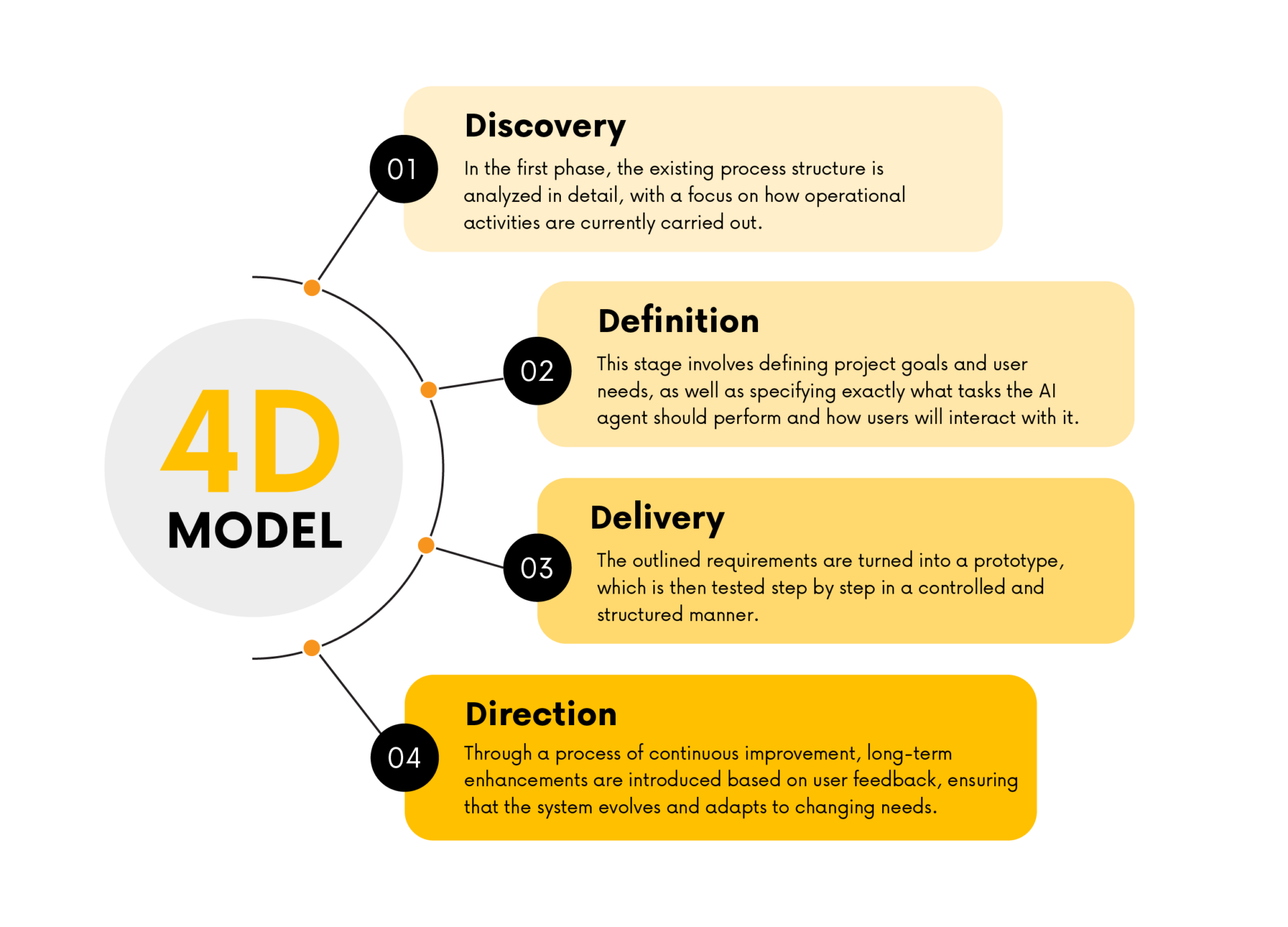
Artificial intelligence offers highly effective and automated support in identifying incidents, performing intelligent request classification, and managing responses. Within incident management, the agent operates autonomously within its assigned permissions, taking over tasks such as sorting, routing, and prioritizing tickets—relieving the workload of human employees.
Using such an AI agent in the IT domain marks a turning point—the software is now capable of independently recognizing and taking on tasks. This is a significant innovation, as the agent can act autonomously within a digital environment.
Incident-related communication can take place in natural language (so-called Natural Language Processing), using a ticketing system powered by artificial intelligence.
Table of Contents
Product Name and Summary of Benefits
The main advantages of automated incident analysis are as follows:
- Automatic Ticket Classification
An AI-powered bot can understand the content of a ticket and automatically assign it to the appropriate category. - Voice-Based Incident Reporting
Users can report incidents naturally via speech, for example through a mobile app. A major benefit is that there’s no need to fill out forms or enter data manually. - Intelligent Routing to the Right Department
The agent understands the context of the report and forwards it directly to the relevant team, saving valuable time. - High Scalability
The agent is capable of processing a large number of requests simultaneously.
User Benefits
The most significant advantage for users is undoubtedly the ability to interact through voice control, without the need to fill out forms. No technical expertise or special skills are required, making the agent a practical solution for people of all ages.
Users also receive real-time feedback—the incident is processed simultaneously as the conversation with the agent takes place. All of this contributes to a highly convenient user experience and a positive overall impression, as the interface is intuitive and easy to navigate, eliminating the need for lengthy training. In most cases, there’s no need for follow-up handling, as any additional questions are addressed immediately during the process.
How We Work – Our Methodology
We begin by analyzing the existing process structures within the organization to identify areas with potential for improvement. We also define appropriate categories and triggers, ensuring that all types of incidents are clearly outlined and the AI bot’s scope of operation is precisely defined.
Our work is based on the 4D model:
- Discover
- Definition
- Delivery
- Direction
This approach will be described in more detail later on. It is an iterative process developed step by step, with continuous integration of user feedback.
From the early stages of the project, real user data is incorporated, and all key stakeholders are involved right from the start. We test using realistic scenarios, and each project phase is delivered using agile methods—with clearly defined steps and objectives. We place strong emphasis on adapting the solution to the existing systems and processes, while also ensuring long-term scalability and future development—so the entire solution can grow with the company and remain ready for new challenges.
Sample Agenda
The implementation of a project is always tailored to the specific needs, expectations, and conditions of the client. The agenda below outlines a potential course of action that can be adjusted for various scenarios.
- Project Kickoff and Goal Definition
At the outset, project goals, timelines, and stakeholder expectations are clearly defined. - Process Analysis and Identification of Weak Points
A review of existing procedures is conducted to uncover areas for improvement. - Data Source Verification and Classification Logic
Which data is available, where it is stored, and how can it be effectively utilized with support? - Application Interface Design
Defining the appearance, content, and functionality of the speech recognition module within the app. - Incident Category Definition
What categories of incidents should be considered within the planned use case? - Helpdesk System Integration
Integrating the solution into the existing ticketing/helpdesk infrastructure. - Prototype Testing and Validation
The first test version is launched with a small group of users under controlled conditions. - Employee Training and Onboarding
Before the go-live, staff receive training on how to use the application effectively. - Official Launch of the Mobile AI Solution
The finalized app is deployed in the production environment. - User Feedback and Technical Support
User feedback is collected and analyzed to improve the solution, and support mechanisms are put in place as needed.
Your Benefits
Eliminating manual ticket handling and improving response times through standardized and clearly structured incident reports leads to more efficient resource utilization. At the same time, customer satisfaction increases, and internal support teams are significantly relieved.
Additionally, operational costs are substantially reduced, and the system can be effortlessly scaled across multiple locations.
As a result, implementing an agent provides a modern, future-proof infrastructure based on artificial intelligence—an infrastructure that is expected to become the industry standard within just a few years.
Next Steps – The 4D Model
Our proven 4D model, used in the implementation of AI-based projects, has demonstrated its effectiveness and is structured as follows:

A Smart Solution: What Is Agent AI in Document Management?
Artificial Intelligence Meets Documents: Definition and Simple Explanation
An agent can take over repetitive tasks such as classifying and routing tickets. It is capable of recognizing and understanding the content of a report, which allows task assignments to be handled automatically. Users are no longer required to fill out forms or use complex input interfaces—they simply communicate in natural language.
Key Features: How Agent AI Understands, Classifies, and Processes Texts
To perform its tasks, the agent utilizes existing tools, and the familiar system environment remains unchanged. This ensures that incident response teams receive immediate access to all necessary information without delay.
The Role of NLP: How Agent Reads and Understands Your Content
Machine learning in incident management enables the automatic detection and classification of reports based on spoken or written language (Natural Language Processing, or NLP). The AI continuously learns from past, current, and future tickets, which makes the system increasingly effective over time. In addition to classification, the agent can also prioritize incoming issues based on the knowledge and experience it has gained.
Implementation of AI Agents in the Incident Management Process
A mobile application enables immediate, voice-based incident reporting. With Speech-to-Text (STT) technology, the spoken report is automatically converted into text. The Natural Language Processing (NLP) module allows the agent to accurately understand the nature of the issue. Based on this analysis, the agent correctly classifies the ticket and forwards it to the appropriate team.
Each report is documented and saved, and the user submitting the incident receives real-time updates on its processing status.
Advantages That Pay Off: Why Investing in Agent AI Makes Sense
Here are some of the key advantages that intelligent ticket classification brings to businesses:
- Reduced response and handling times
- Minimization of human errors
- Standardized communication
- Faster escalation of critical issues
- Greater process transparency
- Higher quality data for analysis
- Measurable improvements in key performance indicators (KPIs)
Challenges and Limitations of Implementing AI Agents
Artificial intelligence learns progressively, which means that, initially, the agent’s performance may not yet meet the desired standards. For example, different ways of phrasing incident reports can pose difficulties in the early stages, although the system gradually learns to recognize and interpret them correctly.
Implementing AI also involves a significant amount of work and poses certain challenges—the integration with existing systems is often complex. During deployment, strict compliance with data protection regulations, internal security policies, and all applicable legal frameworks is essential.
Implementing Agent AI: What to Pay Attention To
Certain approaches to implementing agents have proven particularly effective. These include…
… early involvement of user groups.
… clearly defined data structures and ticket categories.
… use of existing support data to train the AI.
… employee training to boost adoption and confidence.
… flexible rollout in small, manageable phases.
… continuous monitoring and solution refinement.
How the AI Agent Is Revolutionizing Office Life: Practical Use Cases
Ticket Classifier (Mobile App + AI Agent)
This solution consists of a mobile application for field employees (e.g., in property management) and an agent operating in the office. Staff report issues verbally via the app. The AI agent automatically classifies the reports by category (e.g., type of work), standardizes the descriptions, and forwards the service requests to the appropriate contractors.
Benefits:
- Significant time savings (dozens of hours per month) in damage reporting and repair dispatching
- Improved communication
- Faster repair process execution
- More efficient service organization
Data Protection and Security Aspects in the Use of AI Agents
We ensure that all data processing complies with European data protection regulations (GDPR). All information is technically secured, and data encryption during both transmission and storage is mandatory. Access rights are assigned individually, and all user actions are logged and traceable at any time. Regular software updates and technical maintenance are also part of our standard security practices.
Curious how artificial intelligence can boost your company’s efficiency? Get in touch with us—we’ll prepare a customized offer based on your organization’s actual needs.













